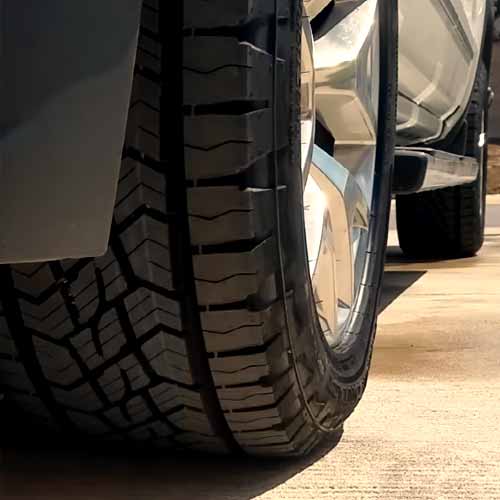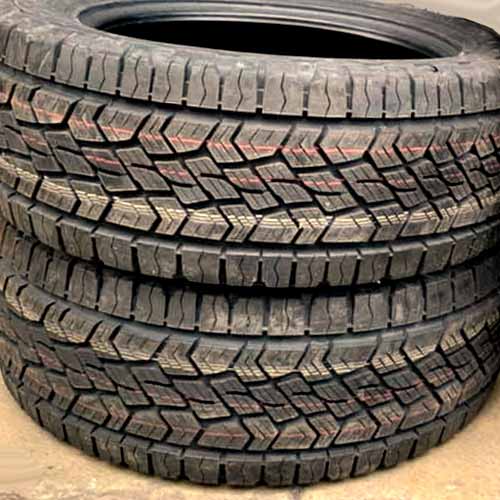Continental TerrainContact AT is an all terrain tire which is very much aligned towards on road, so you can say it’s a mild AT which performs best on pavements, that’s why the tire is specified for SUVs and CUVs use mostly.

Being a tire engineer, from my experience, the Continental TerrainContact AT is a more on road oriented tire which provide amazing dry grip and handling times. Its the best tire that you can get in terms of noise and overall handling in both wet and dry conditions. But the tire really lacks off road and is not as durable. And you can’t expect it to perform so well on snow either, as it’s not branded with 3 Peak Mountain Snowflake rating, like other premium all terrain tires.
Table of Contents
Tire Sizes
The Continental TerrainContact AT comes in a total of 38 sizes, where it ranges from 16 to 20 inches (wheel diameter).
Comes in 38 total sizes going from 16 to 20 inches (rim size).
Speed rating: S, T, H, one of them is also V (255/55/R19).
While the tire has load ratings going from SL to E, so it’s smallest size weighs about 28 lbs, while the heaviest, 66.5 lbs.
Talking about it’s tread depth, LT sizes have 16/32″, where no LT come in 12/32″ where one of the size, 255/55/R19 also has 10/32″ of tread depth.
Durability
AT tires come in a variety of constructions – the construction is dependent on the number of plies. The more plies, the stronger and more durable the tire. The number of plies is a measure of how tight the individual wires are wound together in order to provide strength.
In case of Continental TerrainContact, the tire offers 2 ply polyester casing, which is covered with 2 steel belts.
And these belts are reinforced with spirally wound nylon (just 1 layer).
This construction basically provides 2 ply sidewalls (which is average), and single ply makes it more on road oriented, as the tire keeps its weight at bay.
Tread Appearance
The Continental TerrainContact provides a closed up tread deigns consisting of 5 ribs, making 4 longitudinal channels.

The outer ribs consisting of shoulders have blocks which are joined together with each other (with ridges or you can say connectors).
These blocks are very squared off and don’t make sidewall lugs like other A/Ts.
Towards middle, the tire offers 3 main ribs, each carrying rectilinear sipes, where the middlemost also has full depth notches as well.
the asymmetric tread pattern of these tires offers excellent handling, high stability on curves, and great grip in rainy conditions.
On Road Performance
When it comes to dry highways, there are three important things to keep an eye on: grip, handling & feedback (the steering response of the tire).
Let’s talk about both of these one by one.
Compare Continental TerrainContact AT with others
Dry Grip
On dry roads, the Continental TerrainContact is very civil and provides one of the best traction in the all terrain category. That’s why I rated these tire best here overall in my list of AT tire.
The softer rubber tread of the tire provides a comfortable grip, while the reinforced foundations underneath its blocks provide stability, so the less rigid blocks can still stay in place.
But note that the grip performance of these tires is affected by temperature. In summer, for example, you may experience problems because the compound will soften up more compared to other on road All-Terrain tires.
Steering Response
The steering response determines how your car reacts to the steering input you are providing. It is visually noticeable through the rate of turn in towards or away from that input, as well as how much it quickly responds.
And personally I love the communication the TerrainContact AT provides. The rounded tread pattern of this tire is designed to provide stability at high speeds and shorten the turning radius.
And with a single cap ply, the tire weighs very less, providing amazing balance between under and over steer.
So you get a very low lag time.
Handling Stability
The handling stability of the tire depends on its weight and the shoulder blocks, so again Continental TerrainContact provides you with amazing lateral traction, as it’s very light and offers very stable shoulder blocks with optimized footprint.
The tire offers a great combination of softness and rigidity on it’s shoulders where the soft blocks provides keeps understeering at bay, and the ridges in between the blocks (keeping them stable and stiff), provides less oversteering.
So you get a very balanced ride not only on dry but on wet surfaces as well.
Wet Performance
In wet conditions, traction is greatly reduced due to the water on the road, and that water needs to go somewhere as it’s incompressible. So here sipes comes into action which provide grip, while the grooves provide resistance to hydroplaning.
Lets discuss both of these one by one.
Wet Grip
Wet grip and sipes go hand in hand, the more the sipes, the better the grip, as these sipes basically flex and suck in the water to remove it.
So here one more factor comes alive, the tread’s flexibility, as with a stiffer compound, sipes won’t work (but at the same time they just can’t make it soft all they way, they would wear fast).
The Continental TerrainContact again finds a perfect balance here, it’s sipes are very efficient overall, and it provides one of the best on road wet traction in the category of all terrain tires.
Hydroplaning
Hydroplaning is when your tires lose their traction over a puddle of standing water, due to the water being too large to go through the gaps between your tire’s tread pattern.
So here water cleaning is necessary, and that is done by grooves.
The Continental TerrainContact offers interconnected grooves where water leaves the tire efficiently, so the tire can reach good speeds on water (which is how it’s resistance is measured), on both straight and curved roads.
Winter Performance
Snow traction includes light and deep snow as well as ice, and here a good tire has decent grip, and acceleration abilities along with lateral stability.
Here most of the AT tires get to have 3 peak mountain snowflake (3PMSF) rating, but TerrainContact AT is not one of them.
This rating basically tells how much a tire can accelerate on snow, and all winter tires are qualified for it.
On snow, the sipes structure matters a lot, and here Continental provides you with sipes optimized for wet roads, and so it limits it’s snow traction.
Ride Comfort
Ride comfort of the tire depends on noise and the tire’s ability to soak up the vibrations of the road.
And since Continental focused on road a lot with this tire, the TerrainContact AT is the quietest tire available right now in the AT category.
The tire also offers you with a very comfortable ride, though it’s not the most capable of absorbing the bumps, it still yields good enough results, where it’s softer rubber dampens the imperfections of the road.
Fuel Efficiency
Grip comes at a price, at that price is rolling resistance in the case of Continental TerrainContact AT.
The tire generates a lot of rubber to road contact, and it’s spongy rubber does not want to leave the surface (its on) very easily.
So, the larger rolling resistance values cause it to not only consume more fuel but to wear off quickly as well.
Off Road Performance
Off road although tires are great, some on road aligned tires like our tire here, don’t offer as much effectiveness overall.
Traction on Rocks
On rocks there is a lot, a tire has to face, stones, dirt, big rocks climbing and so on…
The Continental TerrainContact suffers here a little bit with it’s missing stone ejectors and close up shoulder lugs which don’t provide efficient dirt cleaning.
Stone cleaning is very crucial as when stones get lodged in the tread, it not only repel rubber contact, it also damages the tread, even when the compound is cut resistant in case of Continental TerrainContact.
So although you can take these tires on gravel and stones, keep in mind, that they would not perform as great as other AT options, and you would lose tread faster.
In terms of climbing rocks, the tire again is not going to impress, as there are no sidewall lugs for gripping (with lower pressure), so no lateral traction and less climbing power.
But you do get directional grip form the central lugs having curved full depth biters in them.
Mud Performance
Continental TerrainContact AT is not suitable for mud, at all.
It’s super packed up shoulder lugs are just as good as passenger tires here, so you can not expect them to perform at all, even on lighter muddy terrains.
Mud needs to leave, and these tires don’t allow that. There also aren’t any staggered shoulders with mud scoops on these tires, which could have helped.
So where is the tire good at off road? Well personally, I like these tires on sandy beaches, even on sandy dunes.
Sand Performance
Continental TerrainContact AT does great on sand, the tire is soft and with less number of plies (with single cap ply) its light in weight.
Less weight helps the tire with the climb on loose sand, while the softer rubber helps the tire to meet up with the sand properly, so with proper (lower) air pressure, these tires are not so bad after all.
And yes one more thing, though this tire does not offer sharp sides, its actually good on sand, as with smoother edges, this tire does not try to dig in the sand more, and focuses on moving forward (which is exactly what you need here).
To Conclude
Continental TerrainContact AT is although an All Terrain tire, it’s better on roads compared to rougher tracks. In fact, the tire is one of the quietest you can have, it also offers best traction values on both wet and dry roads.
It’s very quiet, where it’s decibels even meet with some passenger tires out there. Same goes for it’s wet and dry traction, where it does great in all key areas, grip, handling, steering response and stability, hydroplaning, you name it.
But note that don’t expect these tires to provide better fuel efficiency, as with more grip, comes more rolling resistance.